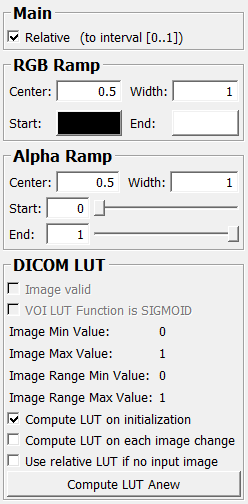RampLUT¶
- MLModule¶
genre
author
package
dll
definition
see also
LUTPrimitive,LinearLUT,TableLUT,ChangeLUTColor,LUTInfo,LUTCurve,ApplyLUT,SoMLLUT,Windowkeywords
Purpose¶
The module RampLUT generates an RGB and alpha ramp lookup table (LUT) object.
The LUT can be used with the ApplyLUT module or within 2D/3D viewers (in conjunction with SoMLLUT). The two ramps for RGB and alpha channels can be parametrized independently.
Usage¶
Select parameters for the RGB Ramp and the Alpha Ramp. For both ramps, specify Center and Width, as well as Start and End color or alpha value.
Connect the outLUT output field to a SoMLLUT module to use the LUT in a 2D/3D viewer, or to an ApplyLUT module to apply the LUT to an ML image.
The module also has an ML image input; if a valid ML image is connected, the module RampLUT can set a default LUT based on the image’s min/max value or, if existing, on the LUT set in the DICOM tags.
Details¶
See LUT Functions for general information about ML lookup tables.
For the exact handling of the DICOM Window Center and Window Width tags, see the Details section of DicomLUT.
Windows¶
Default Panel¶

Input Fields¶
input0¶
- name: input0, type: Image¶
Output Fields¶
outLUT¶
- name: outLUT, type: LUTFunction(MLBase)¶
Parameter Fields¶
Field Index¶
|
|
|
|
|
|
|
|
|
|
|
|
|
||
|
||
|
|
|
|
|
Visible Fields¶
Relative¶
- name: relative, type: Bool, default: TRUE¶
If checked, the generated LUT is relative, i.e., the index value interval [0, …, 1] is rescaled to the true image value range before applying the LUT.
If the LUT is absolute, on the other hand, the image values are used as index values directly, without rescaling.
Center (center)¶
- name: center, type: Double, default: 0.5¶
Sets the center index value of the ramp, either as an absolute image value or relative to [0, …, 1].
Width (width)¶
- name: width, type: Double, default: 1¶
Sets the width value of the ramp, either as an absolute image value range or relative to [0, …, 1].
Start (startColor)¶
- name: startColor, type: Color, default: 0 0 0¶
Sets the color used for index values below the start of the ramp (i.e., index <= center-width/2).
End (endColor)¶
- name: endColor, type: Color, default: 1 1 1¶
Sets the color used for index values above the end of the ramp (i.e., index >= center+width/2).
Center (alphaCenter)¶
- name: alphaCenter, type: Double, default: 0.5¶
Sets the center index value of the ramp, either as an absolute image value or relative to [0, …, 1].
Width (alphaWidth)¶
- name: alphaWidth, type: Double, default: 1¶
Sets the width value of the ramp, either as an absolute image value range or relative to [0, …, 1].
Start (alphaStart)¶
- name: alphaStart, type: Double, default: 0, minimum: 0, maximum: 1¶
Sets the alpha value used for index values below the start of the ramp (i.e., index <= center-width/2).
End (alphaEnd)¶
- name: alphaEnd, type: Double, default: 1, minimum: 0, maximum: 1¶
Sets the alpha value used for index values above the end of the ramp (i.e., index >= center+width/2).
Image valid¶
- name: isImageValid, type: Bool, persistent: no¶
Shows whether the attached image is valid (or if there is no image attached).
VOI LUT Function is SIGMOID¶
- name: isSigmoidVOILUT, type: Bool, persistent: no¶
Shows whether the VOI LUT Function tag of the input image is set to SIGMOID. Nonetheless, the module will always create a linear ramp LUT.
Scale current LUT to new image¶
- name: scaleLUTForNewImage, type: Bool, default: FALSE, deprecated name: useRelativeIfNoInputImage¶
If checked, the scale of the current LUT is applied to any newly connected image.
In other words, if the LUT is defined using absolute values, its relative appearance remains unchanged when the input image changes.
If the input image is disconnected temporarily, the previous scaling is stored and reapplied once a new image is connected.
Keep this option unchecked if you want to use the same absolute LUT for different images. Otherwise, on disconnecting the input image, a relative LUT is computed and on connecting a different image, this relative LUT is used to compute the next absolute LUT. This results in having always the same appearance for images with a different image value range.
If a relative LUT is used by
Relative, this setting has no effect and is therefore disabled in the GUI.If checked,
Compute LUT on each image changewould overwrite the new LUT, so it is also disabled in the GUI.
Compute LUT on initialization¶
- name: shouldComputeLUTOnInitialization, type: Bool, default: TRUE¶
If checked, the module computes the LUT automatically based on the input image on initialization, i.e., after a saved network has been loaded. Otherwise, the stored LUT values (center, width) are used.
Compute LUT on each image change¶
- name: shouldComputeLUTOnEachImageChange, type: Bool, default: FALSE¶
If checked, the module computes a default LUT on each update of the input image.
If checked,
Compute LUT on initializationhas no effect and is therefore disabled in the GUI.
Compute LUT Anew¶
- name: computeLUTAnew, type: Trigger¶
When pressed, a new default LUT is computed using the input image’s DICOM tags.
The following DICOM tags are used: WindowCenter, WindowWidth, SlopeIntercept, and SlopeRescale.
Image Min Value¶
- name: imageMinValue, type: Double, persistent: no¶
Shows the input image’s minimum value (or 0 if no image is attached).
Image Max Value¶
- name: imageMaxValue, type: Double, persistent: no¶
Shows the input image’s maximum value (or 1 if no image is attached).
Image Range Min Value¶
- name: imageRangeMinValue, type: Double, persistent: no¶
Shows the minimum value of the image value range. This is always 0.
Image Range Max Value¶
- name: imageRangeMaxValue, type: Double, persistent: no¶
Shows the maximum value of the image value range.